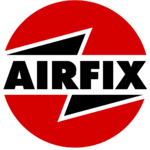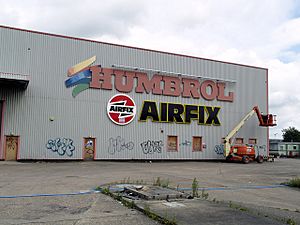Airfix facts for kids
 |
|
| Private (1939–86) | |
| Fate | Acquired by Humbrol in 1986, until its closure in 2006, becoming a brand |
| Founded | 1939 |
| Founder | Nicholas Kove |
| Defunct | 2006 |
| Headquarters | United Kingdom |
| Products | Scale model cars, aircraft, ships, commercial vehicles, military vehicles, railways |
| Brands | Kitmaster (1962–2006) |
| Owner | Hornby plc (2006–present) |
| Parent | Humbrol (1986–2006) |
Airfix is a well-known British brand. It used to be a company that made plastic scale model kits. These kits are made by injecting melted plastic into molds. In the UK, the name 'Airfix' is often used for any plastic model kit.
Airfix made many different plastic models. These included cars, airplanes, ships, trucks, military vehicles, trains, and figures. Airfix started in 1939. From 1986 until 2006, it was owned by a company called Humbrol. Since 2007, both Humbrol and Airfix have been owned by Hornby.
Contents
Airfix History
Airfix was started in 1939 by a businessman named Nicholas Kove. At first, the company made inflatable rubber toys. The name 'Airfix' was chosen so it would be at the very top of business lists.
In 1947, Airfix began using a method called injection moulding. Their first product using this method was pocket combs. In 1949, they were asked to make a special model of a Ferguson TE20 tractor. This model was made of plastic and put together by hand. It was given to sales representatives. To sell more and make them cheaper, Airfix started selling the tractor model as a kit. You could buy it at Woolworths stores.
First Model Kits
In 1954, a buyer from Woolworths suggested that Airfix make a model kit of Sir Francis Drake's ship, the Golden Hind. This ship model was already being sold in North America inside a bottle. Airfix made their version from a stronger plastic called polystyrene. To sell it for a low price, Airfix put the kit in a plastic bag. The instructions were printed on a paper tag attached to the bag. This kit was a huge success! It led the company to create many new model designs.
The first airplane kit came out in 1953. It was a model of the Supermarine Spitfire Mk I. Later, in 1958, they released a Spitfire Mk IX model. This model was in 1⁄72 scale. It was a smaller copy of a larger Spitfire kit made by another company.
Some model builders and former Royal Air Force (RAF) members noticed mistakes in the 1/72 Spitfire Mk I. One person who complained was John Edwards. He was so good at pointing out improvements that Airfix hired him as their chief designer. Edwards helped create a more accurate Spitfire Mk IX model in 1955. He then led the design of many other Airfix kits for 15 years.
How Airfix Grew
During the 1960s and 1970s, Airfix grew a lot as more people enjoyed the hobby. The range of models expanded greatly. They started making vintage and modern cars, motorcycles, and figures. These figures came in both 1⁄76 and 1⁄32 scales. Airfix also made trains, model railway parts, military vehicles, ships, rockets, and spaceships. They kept adding more airplanes, usually in 1⁄72 scale for military planes and 1⁄144 scale for airliners.
As the hobby became more popular, other companies like Matchbox started making similar kits. New manufacturers from Japan and the US also entered the market. During this time, the Humbrol company also grew. Humbrol sold paints, brushes, glue, and other items needed for models. Airfix also had its own range of these products.
Airfix also launched a monthly magazine called Airfix Magazine. It was published from June 1960 to October 1993. There was also an Airfix Magazine Annual in the 1970s.
In 1963, Airfix introduced its slot car racing system. Airfix made cars with special steering. They also sold kits to turn regular Airfix 1⁄32 scale model cars into race cars. The first set included Ferrari and Cooper cars. It came with an 11-foot track shaped like a figure-of-eight. Airfix's slot car system was always less popular than the Scalextric brand. Eventually, Airfix stopped making slot cars.
Most of Airfix's older military vehicles were sold as 1⁄72 scale. However, they are usually considered to be OO or 1⁄76 scale. Later, Airfix added some true 1⁄72 scale vehicle kits. This caused some discussion about the exact scale. Today, Hornby's packaging shows the correct 1⁄72 or 1⁄76 scale.
In 1962, Airfix bought the designs and molds from Rosebud Kitmaster. This gave Airfix its first model railway locomotives and its first motorcycle kit. The motorcycle was an Ariel Arrow in 1⁄16 scale. The 1960s also saw Airfix introduce boxed sets of 1⁄72 scale military figures.
In the mid-1970s, Airfix started making larger models. These included very detailed 1⁄24-scale models of the Spitfire, Messerschmitt Bf 109, Hawker Hurricane, and Harrier "jump-jet". The mid-1970s were a very successful time for Airfix. They released as many as 17 new kits each year. Airfix had 75% of the UK market, selling 20 million kits every year.
Airfix also made many other products besides model kits. These included toys, games, dolls, and art and craft supplies. They also continued to make household plastic items. In 1971, Airfix Industries bought parts of the struggling Lines Brothers toy business. This included the Meccano and Dinky Toys brands. This made Airfix the largest toy company in the UK.
Changes in Ownership
In the 1980s, the Airfix Industries group faced financial difficulties. There were problems with Airfix's other toy businesses. The company declared bankruptcy in 1981.
The company was then bought by General Mills. General Mills also owned a US car kit maker called MPC. The Airfix kit molds were moved to a factory in Calais, France. Airfix airplane kits were then sold in the United States under the MPC name. Some MPC kits were also sold in the UK as Airfix models. Airfix also released MPC kits based on the Star Wars movies.
Four years later, General Mills decided to leave the toy market. They wanted to focus on making food. For a while, it looked like Airfix models might stop being made. No new models were released from 1986 to 1987.
Around this time, Airfix was bought by Borden, Inc.. Borden also owned Humbrol. The molds stayed in France but were moved to Heller SA, another kit manufacturer owned by Borden. This made sense because Humbrol's paints and glues could be used with Airfix kits. Also, the Heller factory had extra space.
In 1994, the Hobby Products Group was sold to an Irish company called Allen & McGuire. It continued to operate under the Humbrol name.
50th Anniversary
In 2003, Airfix celebrated the 50th anniversary of its first airplane kit, the Supermarine Spitfire. The celebration was actually two years early because of a common mistake about the original kit's date. The molds for the very first kit were gone. So, Airfix re-released its 1⁄72 Supermarine Spitfire Mk.Ia kit in blue plastic. The kit also came with a large display stand and looked like the original plastic bag packaging.
Hornby Takes Over

On August 31, 2006, Humbrol, the parent company of Airfix, went into financial trouble. This happened partly because Heller SA, which made most of Airfix's kits, also had problems.
On November 10, 2006, Hornby Hobbies Ltd. announced it would buy Airfix and other parts of Humbrol. Hornby paid £2.6 million for them. Hornby relaunched the Airfix brand the next year. In 2008, Airfix's old factory in Kingston upon Hull was torn down.
Under Hornby's management, Airfix became strong again. Old model ranges were re-released, and Airfix started launching several new kits each year. Most Airfix products are now made in India, while the design and packaging are done in the UK.
Box Art
Many artists have created the pictures for Airfix kit boxes. One of the most famous is Roy Cross.
Model Railways
In 1962, Airfix bought the molds and stock for the Kitmaster railway range. These models were changed to work with Airfix's own railway models. Airfix had been making these since 1960, along with trackside accessories. Only ten of the Kitmaster locomotives were released under the Airfix name.
From 1975 to 1981, Airfix also made ready-to-run models of British railway stock. These were in OO gauge (1⁄76.2 scale). Their details and accuracy were better than similar products from other British companies like Hornby. The range of products grew quickly. A model of a Great Western Railway (GWR) steam locomotive and a GWR auto coach are some memorable releases. Airfix also offered a system that let you control multiple trains on the same track independently.
Airfix also made many plastic kits for both railway stock and scenery items. Some of these, like the footbridge and engine shed, became very well known to almost every railway modeler in the UK.
The brand name for the railway models changed to Great Model Railways (GMR) in 1979. However, the Airfix name was still included. Airfix left the model railway business in 1981. The models were sold to one of its main competitors, Palitoy, which made the Mainline range. The old Airfix molds were later sold to Dapol Ltd and then to Hornby. Dapol still makes most of the kits, but as the molds get old, some kits are being stopped. Hornby continues to make 4 mm/ft scale models from the Airfix molds.
A monthly magazine called Model Trains was published by Airfix starting in January 1980. This magazine had great articles for new people in the hobby. It also covered US and European railways, not just British ones. The magazine continued to be published for some years after Airfix stopped owning it in 1981.
Video Game
In 2000, EON Digital Entertainment released a video game called Airfix Dogfighter for computers. The game featured computer versions of Airfix's World War II-era model airplanes. There were over 15 planes you could play as, including the German Messerschmitt Me 163 Komet and the American Grumman F6F Hellcat.
The game had 20 missions. Players could play 10 missions as the Axis powers and 10 as the Allies. Players fought inside a 1950s-era house. They had to destroy enemy planes and collect items like healing glue packets, new model kits, weapon plans, and paint. You could use the paint to customize your aircraft for online battles. Pilots fought against enemy model airplanes, U-boats, warships, tanks, anti-aircraft guns, airships, and fortresses. Players could also design their own fighting symbol, call sign, and even their own battle maps based on the game's missions. The game was also a way to advertise. The paints shown were Humbrol, and the kit upgrades showed actual pictures of Airfix packages.
See also
 In Spanish: Airfix para niños
In Spanish: Airfix para niños


